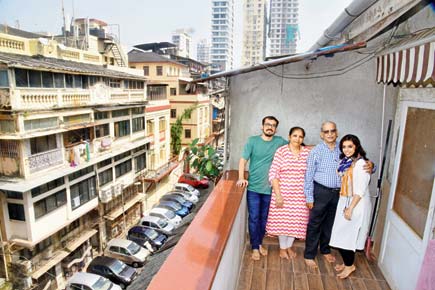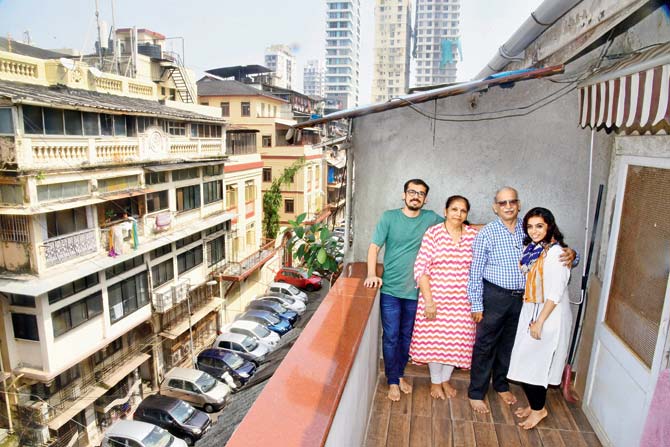A book on the lives that the city leads, At Home in Mumbai, introduces you to the stories that simmer behind its most interesting doors

Bhatia Niwas is one of the many low-rise buildings lining the cul-de-sac that is home mostly to the Gujarati community. For nearly 100 years or more, it has resisted change, redevelopment, holding on to its peculiar facades, oddly designed homes and innumerable stories of how a community survived the calamities that swept through the rest of the city. Change has so far been turned away from the gates of this impenetrable neighbourhood where residents are bound by habit and shared lives.

ADVERTISEMENT
Is it lost in time? Perhaps. Because when you step away from the bustling main street of Chira Bazaar, and walk past the rows of cars and two-wheelers parked parallel to the kerb and start climbing the wooden stairs, you feel drawn deeper and deeper into a secret world. Every time the stairs land at a doorway, you see something different. An old, well-worn ladder going up to an improvised wooden machan, a pair of eyes watching you from behind iron grilles; a dog waiting for its humans. Every plank of wood, every crack in the walls, every door is oozing memories.
The Sampats live on the third floor. They share their main entrance with their neighbours, besides their keys and many stories. A slim common corridor takes you past the room that belongs to their neighbour on one side, and their kitchen on the other, a common bathroom and toilet make up for the rest of the shared floor space between the families.
The Sampats' room and kitchen are identical to that of their neighbours. A perfect example of how the industrious and relatively more prosperous Gujarati trading community took the concept of shared facilities of a chawl and turned it into a more sophisticated living quarter. Each floor is home to no more than two families. So, what if they share a bathroom and a main door and a common passage? They have their own viewing gallery, or balcony. It is luxurious by Mumbai standards. Or used to be.
Over the years, the Sampats, like the other families in this eighty-seven-year-old building, have personalised their quarter to meet the changing demands of the family and the expectations of the younger family members.
Vishal Sampat, a marketing executive, is the elder child of the family. His younger sister Neha is a doctor employed with the civic body. They have grown up in the only room with their grandparents and parents, sleeping on the floor or on the sofa-cum-bed. The kitchen, more spacious than what you would see in a typical chawl, was where Vishal's uncles and aunts and his parents spent the nights when they were newly married. Today, it has been souped up with all the modern gadgets and tricks needed to make the homemaker's life easier.
We are having black chana and shrikhand as part of a lavish lunch spread in the family room – the walls of which have been taken up by a cleverly designed wardrobe that evidently has room for every member in the family and their varied sartorial choices. Vishal's sister Neha pulls out her bag and other accessories from the closet, checks her gorgeous reflection in the mirror on one of the doors, shares a few pleasantries with us before rushing to a social engagement.
Vishal's mother is a quiet, assuring presence in the house, sailing from kitchen to table to balcony to closet, with quiet dignity. A very active member of the local clubs and other women's committees, she tells me about the time she married and moved into the house her husband's grandfather had bought. There were eight members in the house. The newlyweds always had the privilege of sleeping in the only room that afforded privacy -- the kitchen. Did I just see a little twinkle in her eyes?
Today, the kitchen looks very different, of course. It has a steep, improvised flight of stairs to a sprawling loft or a mezzanine floor that had been added sometime in the 1990s.
The 'loft' hangs over the large family room, almost like a parent watching over your shoulder. This hanging room is home to the senior Sampats these days, with a bed and a cupboard that literally melts into the room.
Everything in the apartment has been designed to make use of every inch of space available to the residents. There is no wastage. There is room for everyone here, and perhaps it could have room for more as and when Vishal chooses to get married.
Excerpted with permission from At Home in Mumbai, by Chandrima Pal, published by HarperCollins India
 Subscribe today by clicking the link and stay updated with the latest news!" Click here!
Subscribe today by clicking the link and stay updated with the latest news!" Click here!







